Bring the spirit of New Orleans into your kitchen with this incredible homemade King Cake Recipe! This isn’t just any king cake – it’s a perfectly braided, pillowy-soft pastry filled with a buttery cinnamon swirl and topped with a bright lemon glaze and colorful sugars. Grab my success tips below!
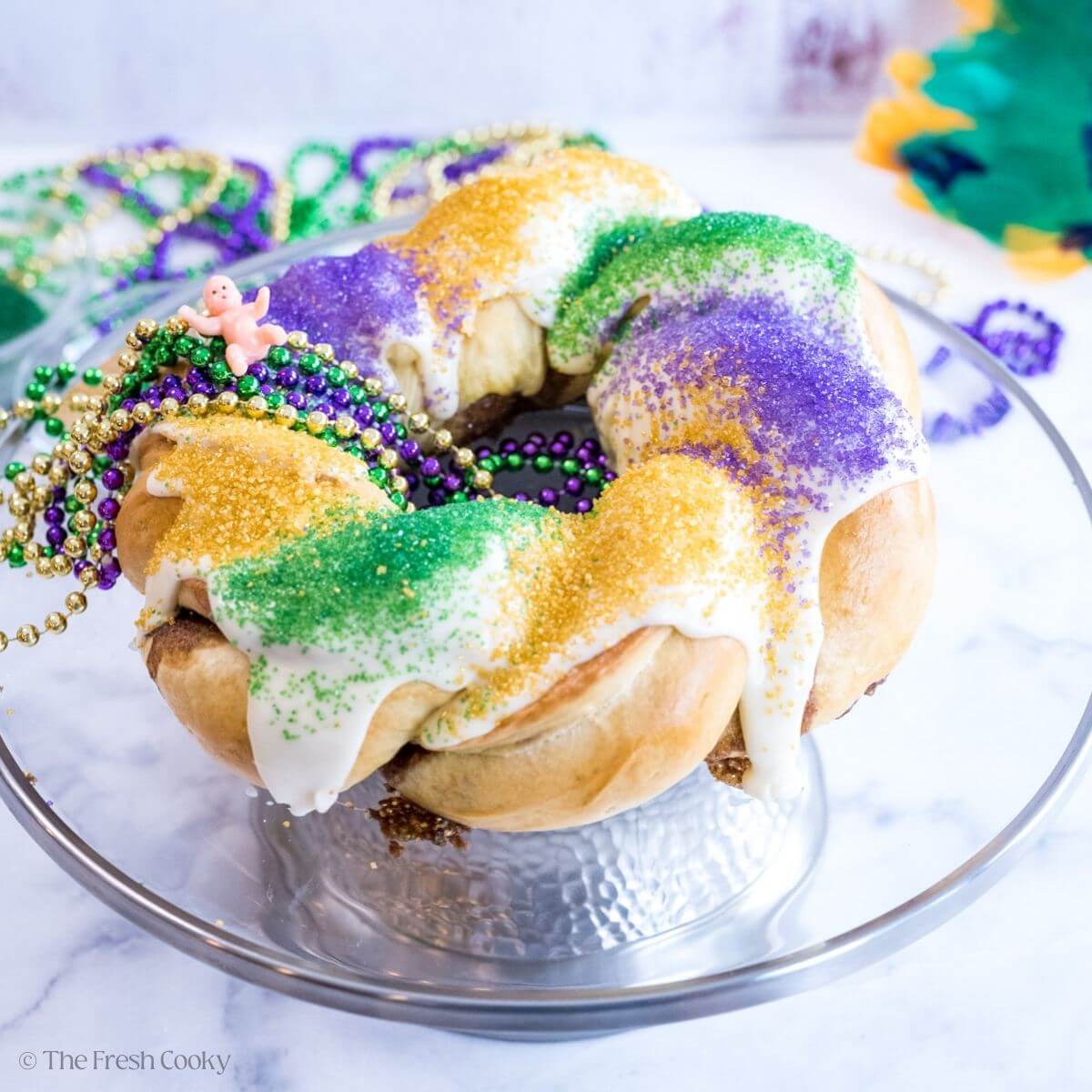
I enjoy giving precise details in my recipe posts to lead my readers through any questions. If you’re just here for the printable recipe, use the Jump to Recipe to head straight there!
What is a King Cake?
Chances are you already know what a King Cake is—but just in case, here’s a quick recap. It’s a sweet, ring-shaped pastry eaten during Mardi Gras season. Soft dough, cinnamon swirled, sweet glaze and sprinkles, it’s festive and delicious. And don’t forget the baby (or pecan)! Whoever finds it gets good luck and gets to bring the next King Cake.
Today, King Cakes come in many flavors: cinnamon sugar, cream cheese, praline, and fruit-filled. My version is traditional New Orleans style, using a slightly modified version of my popular cinnamon roll recipe with a touch of vanilla and lemon. Whether you’re celebrating Epiphany, Mardi Gras or just love a good sweet bread, this King Cake brings it home!
Success Tips for the Best King Cake
I had so much fun testing this recipe; my recipe testers came back for seconds and thirds—always a good sign! Here are a few tips to make sure your King Cake turns out perfectly:
- Watch Your Dough – The dough should be tacky but not sticky. Add flour gradually if needed but don’t overdo it! Adding too much flour will make it tough.
- Let it Rise – Give the dough enough time to double in size for the best texture. If your kitchen is cool, use a proof setting on your oven or let it rise in a warm spot.
- Seal It Well – When rolling and shaping, pinch the seams closed tightly so the filling stays put. A little water on your fingertip will help seal the dough better, preventing leaks while baking. But don’t worry, a little oozing is just fine!
- Frost While Warm (But Not Hot!) – Let your cake cool slightly before frosting so it doesn’t melt completely, but adding it while warm gives the best gooey drizzle. Or cool it completely if preferred.
- Warn Eaters About the Baby! – Seriously, remind your eaters there’s a tiny plastic baby (or pecan) inside. I thought I had warned everyone at a church function—I even put up a sign! But one guy bit it three times before realizing what it was. Thankfully, no dental work was needed, and we all had a good laugh! Be careful while you slice it; if you slice the baby, it’s considered bad luck!
Most importantly, have fun with it! Whether you’re making this for Mardi Gras, a party, or just because, this cake is all about celebration, tradition, and sharing something delicious!

Mardi Gras King Cake Ingredients
- Whole Milk: Full-fat milk creates the most tender dough! But you can use other percentages.
- Butter: I use salted grass-fed butter in most of my recipes; if using unsalted butter, increase the salt by ¼ teaspoon. Use quality butter
- Sugar: I use all-natural cane sugar in most of my baking; granulated sugar works too.
- Vanilla Extract: For the best flavor.
- Lemon Zest: Adds a light citrus flavor to the dough.
- Kosher Salt: To balance the flavors and prevent too much gluten from forming in the dough.
- Eggs: Eggs provide structure and richness to the tender dough; I use large room-temperature eggs.
- Bread Flour: Bread flour is best, creating a softer bread. You can use all-purpose flour, but the dough will be a little tougher, but still good.
- Instant Dry Yeast: I like to use Saf Brand Instant Yeast!
- Optional Egg Wash: Egg yolk and cream, milk or water
- Cinnamon Sugar Filling Ingredients: Room temperature butter, cinnamon (add a dash of nutmeg if you want too) and brown sugar.
- Frosting Ingredients: Powdered sugar, lemon juice (fresh squeezed), melted butter, vanilla, milk or cream, salt, and sprinkles*.
- Plastic Baby: You’ll need one small plastic baby (or use a pecan). If you can find just one, great—but good luck! I ended up buying a package of 36 on Amazon, so now I have enough for years of King Cakes…or a baby shower!
*Note: Traditional Mardi Gras colors are gold, purple, and green! Craft stores like Hobby Lobby, JoAnns often have many colored sugars to choose from or Amazon. Use yellow for the gold or switch the colors up altogether.
Get the full recipe in the recipe card below.

How to Make a King Cake
Step 1 – Making the Dough
In a saucepan, warm milk, butter, sugar, and salt to 120°-130°F (watch closely). If overheated, let cool before adding to yeast. Use an instant-read thermometer.


In a stand mixer with a paddle attachment, combine 2 cups flour and yeast. Slowly add the warm milk mixture while mixing on low.
Mix in eggs, lemon zest, and vanilla.
Slowly add 2 ¼ more cups of flour, mixing well. The dough should be soft but not sticky (add more flour one tablespoon at a time as needed), up to ¾ additional cups. The dough should not be sticking to the sides of the bowl, but it’s okay if it sticks to a small portion of the bottom of the bowl.
Switch to a dough hook and knead for 5-10 minutes until smooth and elastic (or knead by hand for 8-10 minutes). Remove from the bowl and knead several times to create a round ball.



Lightly grease a bowl, place dough inside, flip and cover, and let rise in a warm place 1-2 hours until doubled. Option: Cover and refrigerate overnight; bring to room temp before shaping.
Tip: If your house is cooler, it will take longer for the dough to rise, if warmer, it will be shorter.


Tip: Did you forget to take eggs out? Place in warm (not hot) water for 5-7 minutes.
How to Proof Dough: If your oven has a proof setting, set it to 75°F. If not, preheat to 100°F, then turn it off and place the dough inside.
Step 2 – Making the Cinnamon Filling
Mix butter, brown sugar, cinnamon, and salt in a bowl until smooth and creamy. Use a mixer or mix by hand.
Store covered at room temp for 1 day or refrigerate in an airtight container for up to 1 week. Bring to room temp before using.


Step 3 – Rolling and Shaping the Dough
On a lightly floured surface, roll dough into an 18×21-inch rectangle (or two smaller 9×12-inch rectangles).
Using a pizza cutter, cut in half lengthwise to create long strips.

Using an offset spatula, spread cinnamon filling evenly down the center of each strip, leaving a 1-inch border. (If using cream cheese filling, do the same)
Roll each strip into a cylinder, pinching seams closed.


Place two rolls side by side, pinch the top ends together, then twist into a rope braid and form a ring or oval. Pinch ends together and tuck under. (Repeat if making two cakes.)


Then move the dough onto a parchment-lined half sheet baking pan. Cover loosely and let rise 30-45 minutes until puffy.

Step 4 – Baking the King Cake
Preheat oven to 350°F (175° C) while the dough rises.
If using an egg wash, whisk egg yolk and cream, milk or water, then brush over the cake.
Bake 25-35 minutes until golden brown. Use an instant-read thermometer—it’s done at 190°F-195°F.
Cool at least 30 minutes before frosting so the frosting doesn’t melt off. Or cool completely, and see below for how to rewarm the King cake.


Step 5 – Making the Frosting
In a small bowl, whisk together powdered sugar, lemon juice, melted butter, vanilla, and salt.
Gradually add milk/cream (1 tablespoon at a time) until pourable and desired consistency. You want this glaze on the thicker side.

Step 6 – Decorating and Serving
This is the fun part! Hide the baby (or pecan) by pressing it into one of the seams until you can’t see it any longer, the frosting will cover any sign of it. You may also go from the bottom and press it into the cake.

Drizzle frosting over the cooled cake, then immediately sprinkle with purple, green, and gold sugars before it sets.



King Cake Mardi Gras Traditions
King Cake is a big part of Mardi Gras, the season between Epiphany and Fat Tuesday. The tradition comes from Europe where cakes like Galette des Rois and Roscón de Reyes were eaten on Epiphany to celebrate the Three Wise Men’s visit to baby Jesus. These cakes had a hidden bean or figurine to symbolize good luck.
French settlers brought the tradition to New Orleans where it became a Mardi Gras staple. Over time the cake evolved into the sweet, ring-shaped brioche-style pastry we know today, decorated in purple, green and gold for justice, faith and power. Now instead of a bean, a tiny plastic baby (or pecan) is hidden inside for good luck.
Finding the baby is all in good fun! The lucky person is crowned “king or queen for the day” and is supposed to have good fortune in the coming year. But there’s a catch—tradition says they have to host next year’s party or bring the next King Cake!

Best King Cake Recipe Tips
Troubleshooting & Success Tips
- Watch Your Dough – It should be tacky, not sticky. If it’s too wet, add flour a little at a time, but don’t overdo it!
- Let It Rise – Dough needs time to double in size for the best texture. If your kitchen is cool, use a proof setting on your oven or place it in a warm spot.
- Seal It Well – When rolling and shaping, pinch seams tightly to keep the filling inside. A little water on your fingertip helps seal it, but don’t stress—a little oozing is totally fine!
- Let the cake cool at least 30 minutes before frosting so it doesn’t completely melt off the cake.
- Don’t Forget the Baby! – Remind everyone there’s a small plastic baby (or pecan) inside!
- Dough Too Sticky? – Humidity affects dough. Add 1-2 tablespoons of flour at a time, kneading until it’s manageable. Avoid over-flouring or your cake may turn out tough.
- Yeast Issues? – If using Active Dry Yeast, proof it first:
- Mix ¼ cup warm water (reduce milk by ¼ cup) + 1 teaspoon sugar + yeast.
- Let sit 5-8 minutes until foamy, then proceed.
- Dough Won’t Rise? – Check if your yeast is fresh and that your milk wasn’t too hot (which can kill yeast). If your kitchen is cool, place the dough near a warm oven or on top of the fridge.
- No Braid? No Problem! – Skip the braid and just shape the dough into an oval ring.

Make-Ahead Tips
- Cinnamon Filling – Store at room temp for up to 1 day or refrigerate for up to 1 week. Bring to room temp before using.
- Cream Cheese Filling – Refrigerate for up to 1 week. Bring to room temp before using.
- Dough Prep – Remove butter, eggs, and cream cheese from the fridge ahead of time.
- Prep your dough before the first rise, and then place the covered bowl in the fridge overnight. Remove the dough in the morning and allow to rise until doubled.
High Altitude King Cake Adjustments
I have recipe testers nationwide, so my recipes are tested at sea level and higher elevations. I personally bake at 5,280 feet (Mile High City), and my high-altitude adjustments are listed below.
- Add 2-4 tablespoons extra flour (adjust based on dough texture; if it’s too sticky, add a tablespoon at a time).
- Normally, I would increase the oven temperature by 25° for my baking recipes, but during testing, the pastry came out better at 350°F (175° C) than at the higher temperatures. Just make sure you bake it long enough. The dough should be nice and golden on top.

How to Store Homemade King Cake
Since King Cake is made with a cinnamon roll-style dough, it’s best enjoyed fresh, but here’s how to keep it soft and delicious for longer:
- Room Temperature: Store loosely covered at room temp for 2-3 days. Use plastic wrap or foil, but don’t wrap too tightly or it may become sticky.
- Refrigerate (if necessary): Avoid refrigerating unless absolutely necessary, as it can dry out the dough. If your cake has a cream cheese filling, store it in an airtight container in the fridge for up to 5 days. Let it come to room temperature before serving or warm slices briefly in the microwave.
How to Freeze King Cake
If you haven’t frosted your King Cake yet, it’s best to wait until after thawing. But if it’s already frosted, place the cake on a baking sheet in the freezer for 1 hour to flash freeze. Then, wrap it tightly in plastic wrap (twice for extra protection) and cover with foil or a freezer-safe baggie—this is how I stored my second King Cake.
Freeze for up to 3 months. When ready to serve, thaw overnight at room temperature and warm slightly before enjoying!
For the best texture, room temperature or freezing is ideal—only refrigerate if needed!
How to warm King Cake?
I personally like my pastry warm, so I tested several ways to warm your cake!
To warm up a King Cake without melting the frosting, set your oven to 325°F (163°C). If reheating a whole cake, loosely cover it with foil and warm for about 10 minutes. Place individual slices on a baking sheet and heat for 5-7 minutes.
If your cake has been refrigerated, let it sit at room temperature for 15-20 minutes before warming. For a quick option, you can microwave slices on a low setting for 10-15 seconds, which keeps the cake soft without melting the glaze. This method ensures your King Cake is warm, fresh, and just as delicious as when it was first baked!

Traditional King Cake Recipe FAQs:
The baby symbolizes baby Jesus, as King Cake was traditionally served on Epiphany (Three Kings Day). Today, it’s become a fun Mardi Gras tradition where finding the baby brings good luck and responsibility!
King Cake season begins on January 6th (Epiphany) and continues through Mardi Gras. The cake is shared at gatherings, and whoever finds the baby is crowned “king” or “queen” for the day and is traditionally responsible for providing the next King Cake!
Finding the baby means you’re the lucky king or queen of the party! Traditionally, you’re also responsible for buying or making the next King Cake or hosting next year’s celebration. But what a fun responsibility!
Yes and No. If you purchase plastic babies specifically made for a King Cake they are “considered” safe to bake inside. However; I have a personal issue with baking and plastic, so I prefer to press the baby into the cake after baking, then frost to keep the surprise.

Recipe Variations
While this king cake recipe features the classic cinnamon filling, king cakes come in many delicious variations:
- Cream cheese filling (recipe provided in recipe card)
- Praline or pecan filling
- Almond paste filling
- Fruit preserves
- Chocolate or hazelnut spread
- Traditional Galette des Rois style with almond cream
No matter how you slice it—whether you go the traditional route or mix things up—the best part of King Cake is sharing it with others and soaking up the fun of Mardi Gras!

More Mardi Gras Recipes We Love
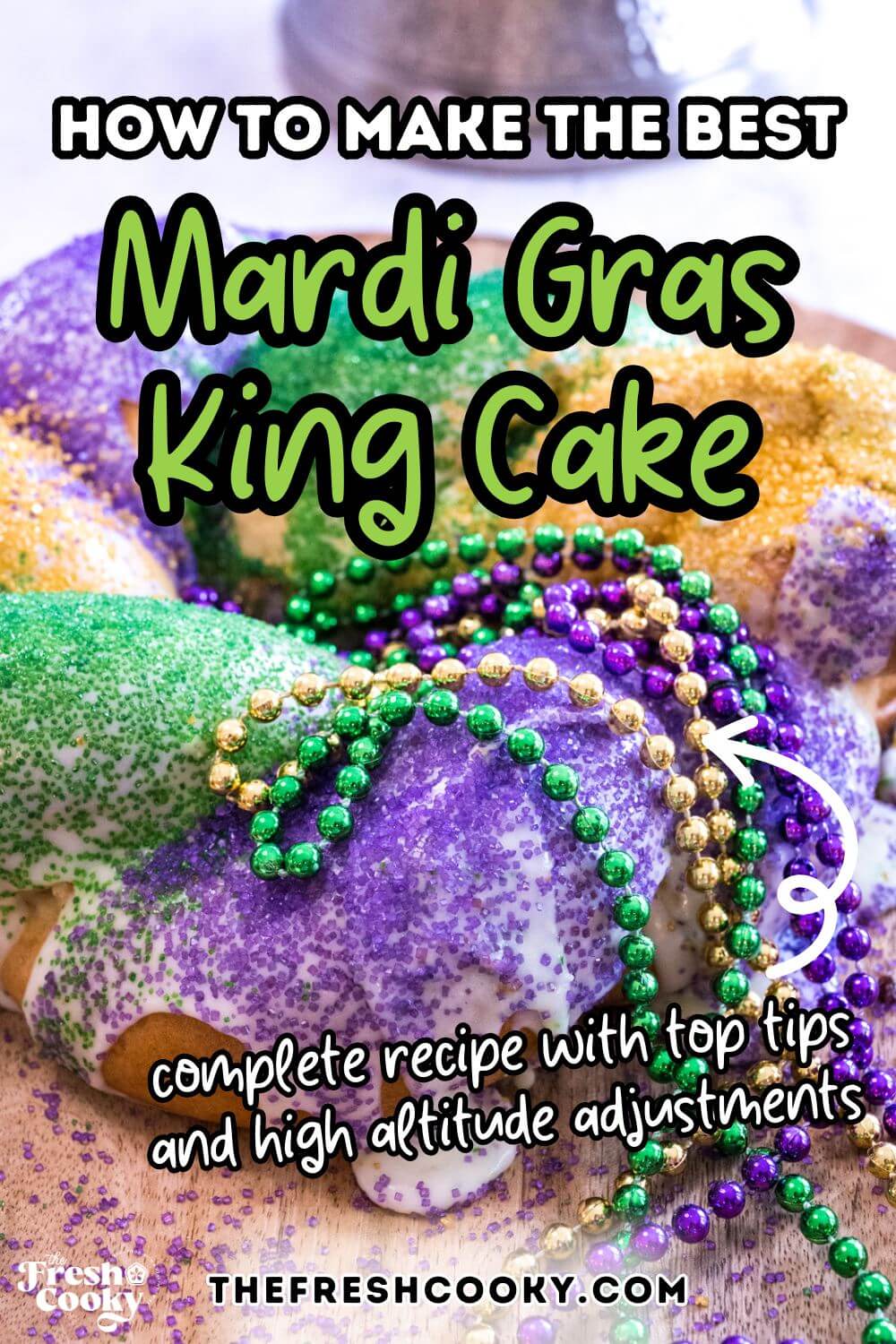
More Popular Recipes from The Fresh Cooky
Like this recipe?
Don’t forget to give it a ⭐️⭐️⭐️⭐️⭐️ star rating and leave a comment below the recipe!
Ingredients
King Cake Dough
- 1 cup whole milk
- ⅓ cup butter room temp, I use salted butter
- ¼ cup cane sugar
- 2 teaspoons vanilla extract
- 1 teaspoon lemon zest
- ½ teaspoon kosher salt
- 2 large eggs room temp
- 4 – 5 cups bread flour or all-purpose flour, it may be tougher, see note 1
- 2 ¼ teaspoons instant dry yeast = 1 packet yeast. I prefer Saf Brand. See note 2
Traditional Filling (fills one large or two small cakes)
- ½ cup butter room temp
- 1 ½ tablespoons cinnamon add ¼-1/2 teaspoon nutmeg if desired
- 1 cup packed brown sugar or half brown sugar, half granulated
Frosting
- 2 cups powdered sugar
- 1 tablespoon lemon juice fresh squeezed is best!
- 2 tablespoons melted butter I use salted, but add a little bigger pinch if using unsalted
- 1 teaspoon vanilla extract
- 2 – 3 tablespoons milk or cream
- pinch of salt
Optional Egg Wash (for a glossy finish)
- 1 egg yolk room temp
- 1 tablespoon milk or water for a crisper finish
Optional Cream Cheese Filling (fills one large or two small cakes)
- 8 ounces cream cheese softened
- 1 – 1 ½ cups powdered sugar
- 1 teaspoon lemon zest
- 1 teaspoon vanilla extract
- pinch of salt
Instructions
Making the Dough
- In a saucepan, warm milk, butter, sugar, and salt to 120°-130°F (watch closely). If overheated, let cool before adding to yeast. Use an instant-read thermometer.
- In a stand mixer with a paddle attachment, combine 2 cups flour and yeast. Slowly add the warm milk mixture while mixing on low.2 ¼ teaspoons instant dry yeast
- Mix in eggs, lemon zest, and vanilla.
- Slowly add 2 ¼ more cups of flour, mixing well. The dough should be soft but not sticky (add more flour 1 tablespoon at a time until no longer sticky, but only tacky), up to ¾ additional cups. The dough should not be sticking to the sides of the bowl, but its okay if it sticks to small portion of the bottom of the bowl.4 – 5 cups bread flour
- Switch to a dough hook and knead for 5-10 minutes until smooth and elastic (or knead by hand for 8-10 minutes). Remove from the bowl and knead several times to create a round ball.
- Lightly grease a bowl, place dough inside, flip and cover, and let rise in a warm place 1-2 hours until doubled (see notes). Option: Cover and refrigerate overnight; bring to room temp before shaping.
Making the Cinnamon Filling
- In a bowl, mix butter, brown sugar, cinnamon, and salt until smooth and creamy. Use a mixer or mix by hand. Store at room temp for 1 day or refrigerate for up to 1 week. Bring to room temp before using.If using the cream cheese filling, beat ingredients together until light, fluffy and creamy.½ cup butter, 1 ½ tablespoons cinnamon, 1 cup packed brown sugar
Rolling and Shaping the Dough
- On a lightly floured surface, roll dough into an 18×21-inch rectangle (or two smaller 9×12-inch rectangles). I rolled a large rectangle, then cut it in half and half again.
- Using a pizza cutter, cut in half lengthwise to create long strips.
- Using an offset spatula, spread cinnamon filling evenly down the center of each strip, leaving a 1-inch border. (If using cream cheese filling, do the same)Roll each strip into a cylinder, pinching seams closed. The move the dough onto a parchment lined half sheet baking pan. Tip: Wet your fingers with water and wet the seam before pressing for a better seal.
- Roll each strip into a cylinder, pinching seams closed.
- Place two rolls side by side, pinch the top ends together, then twist into a rope braid and form a ring or oval. Then move the dough onto a parchment lined half sheet baking pan.Pinch ends together and tuck under. (Repeat if making two cakes.)
- Cover loosely and let rise 30-45 minutes until puffy.
Baking the King Cake
- Preheat oven to 350°F (175° C) while the dough rises. If using an egg wash, whisk egg yolk and milk/water, then brush over the cake. Milk will give you a softer finish, water more crisp.1 egg yolk, 1 tablespoon milk
- Bake 25-35 minutes until golden brown. Use an instant-read thermometer—it’s done at 190°F-195°F. Cool at least 30 minutes before frosting or cool completely.
Making the Frosting
- In a bowl, whisk together powdered sugar, lemon juice, melted butter, vanilla, and salt. Gradually add milk/cream (1 tablespoon at a time) until pourable.2 cups powdered sugar, 1 tablespoon lemon juice, 2 tablespoons melted butter, 1 teaspoon vanilla extract, 2 – 3 tablespoons milk or cream, pinch of salt
Decorating and Serving
- Hide the Baby – Press a plastic baby (or pecan) into the King Cake before frosting.
- Glaze and Sprinkle – Drizzle frosting over the cooled cake, then immediately sprinkle with purple, green, and gold sugar before it sets.
- Slice and Serve – Whoever finds the baby is king or queen for the day!
Notes
- Dough Too Sticky? – Humidity affects yeast dough. If sticky, add 1-2 tablespoons flour at a time, kneading until tacky (not sticky). Avoid over-flouring—too much makes the cake tough.
- Yeast Issues? – If using Active Dry Yeast, proof it first:
- Mix ¼ cup warm water (reduce milk in the recipe by ¼ cup) + 1 teaspoon sugar + yeast.
- Let sit 5-8 minutes until foamy, then proceed with the recipe.
- Dough Won’t Rise? – Possible reasons:
- Yeast was expired or milk was too hot, killing the yeast.
- Kitchen too cool—try placing dough near a warm oven or on top of the fridge. Or preheat oven to 75°F or if your oven doesn’t go that low, to 100°F then turn off and place your dough inside.
- No Braid? No Problem! – You can skip the braid and shape the dough into an oval ring.
- Add 2-4 tablespoons extra flour (adjust based on dough texture, if too sticky, add a tablespoon at a time).
- Normally, I would increase the oven temperature by 25° for my baking recipes, but during testing found that the pastry came out better at 350°F than at the higher temperatures. Just make sure you bake it long enough.
- Cinnamon Filling: Store at room temp for up to 1 day or refrigerate for up to 1 week. Bring to room temp before using.
- Cream Cheese Filling: Refrigerate for up to 1 week. Bring to room temp before using.
- Dough Prep: Remove butter, eggs, and cream cheese from the fridge ahead of time.























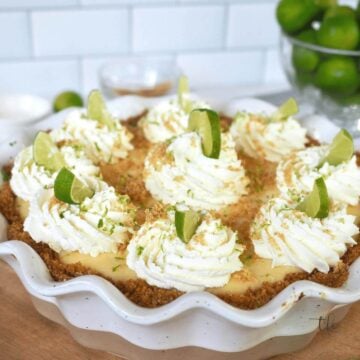
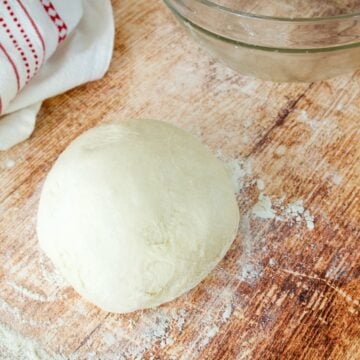

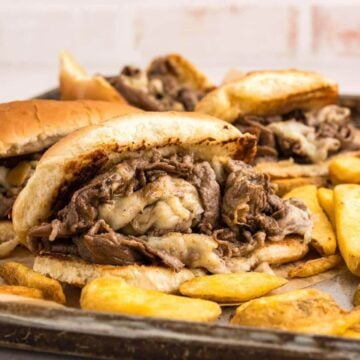
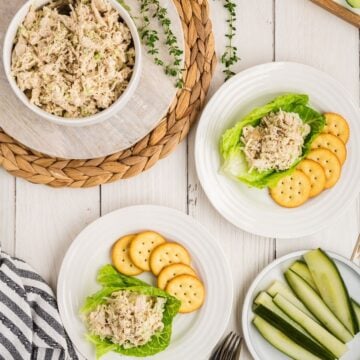
Rate & Comment